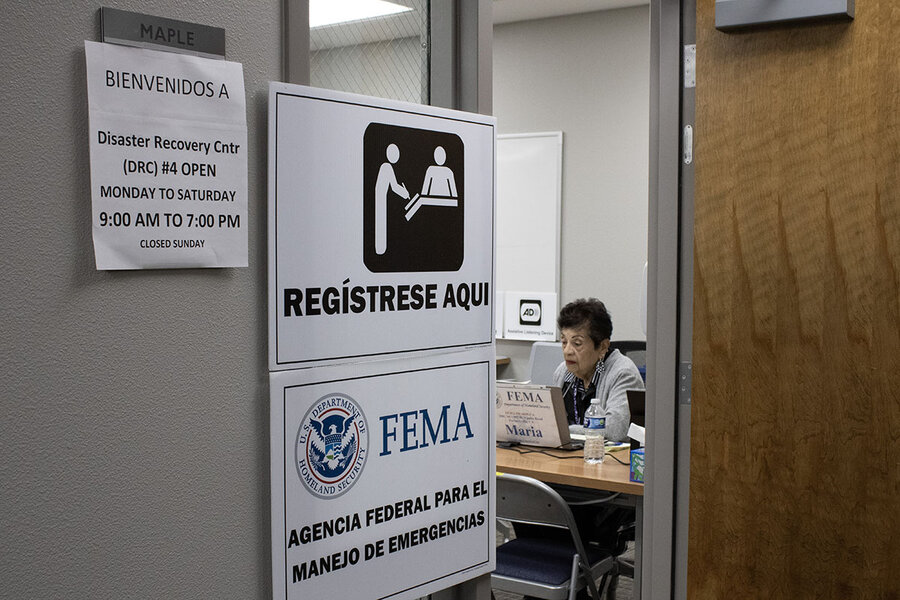As disasters grow in scale, is government aid fairly distributed?
Loading...
The four-decade trend on natural disasters is clear: Bigger storms, translating into bigger spending in recovery efforts. Some of this year's big examples include Maui wildfires and California flooding.
In August, the Federal Emergency Management Agency announced its reserves were running low, prompting the Biden administration to request an additional $4 billion to get the agency through the end of the year. The request was granted, but there is an added twist. The impact of natural disasters and the federal funding that follows are not always distributed equitably.
Why We Wrote This
This year saw a record number of $1 billion-plus natural disasters. Aid doesn't always get to those who need it most, making equity a rising priority for federal assistance.
Research by experts at Rice University and the University of Pittsburgh found that predominantly white communities saw higher levels of prosperity recover and grow after disasters, while wealth in predominantly Black communities decreased.
FEMA officials say they are making progress on delivering post-disaster assistance faster, to more people, and with greater attention to equity. Steps have included new formulas for calculating losses on homes.
The NAACP and FEMA signed an agreement in September that outlined ways the organizations would collaborate to consider equity in disaster preparedness and response.
“We cannot continue the status quo,” says Abre’ Conner, director of environmental and climate justice for the NAACP.
When it comes to natural disasters, 2023 has been a record setter. From the Maui wildfires to Hurricane Idalia to California flooding, 25 confirmed weather disasters in the United States so far this year have racked up losses exceeding $1 billion, according to the National Oceanic and Atmospheric Association. That’s triple the amount for an average year since 1980.
And, although 2023 lags behind other years in the total dollar-value of damages, the four-decade trend is clear: bigger storms, translating into bigger spending in recovery efforts.
In August, the Federal Emergency Management Agency, the government agency responsible for disaster aid, announced its reserves were running low, prompting the Biden administration to request an additional $4 billion to get the agency through the end of the year.
Why We Wrote This
This year saw a record number of $1 billion-plus natural disasters. Aid doesn't always get to those who need it most, making equity a rising priority for federal assistance.
The request was granted in September, but there is an added twist. The impact of natural disasters and the federal funding that follows are not always distributed equitably. The agency is responding to pressure to address that challenge.
What is FEMA and how does it operate?
The agency is responsible for coordinating government relief efforts for natural disasters and emergencies. The governor of a U.S. state or territory must ask the president to declare a natural disaster or state of emergency and then authorize emergency relief funding. The federal government contributes 80% to relief effort costs while local governments cover the remaining 20%.
Stephen Flynn, founding director of the Global Resilience Institute at Northeastern University, describes FEMA as an operational agency. “It’s all about the paperwork that allows the federal government to pick up the cost of getting water, getting shelter, and getting things put back together again,” he says.
In recent years the White House began preemptively declaring natural disasters, says Mr. Flynn, in order to speed up the process of communities receiving aid.
How is FEMA adapting to meet a changing climate?
Congress has updated or reformed the nation’s emergency management systems a number of times in response to disasters, including some that scientists consider amplified by human-caused warming of Earth’s climate.
Legislation after Hurricane Katrina in 2005, plus the Disaster Recovery Reform Act of 2018, focused on enhancing FEMA preparedness and enabling faster assistance to affected people.
Some experts have raised the idea that it’s unsustainable to keep rebuilding the same areas that are prone to disasters.
With flood risks rising for many Americans, the Department of Homeland Security submitted legislative proposals to reform FEMA’s National Flood Insurance Program in April 2023. The proposed changes aim to keep flood insurance affordable while also keeping the program fiscally sound and addressing the risk of “repetitive loss properties,” the agency says.
Is FEMA relief distributed fairly?
The agency’s five-year strategic plan includes as its first goal instilling equity as a foundation of emergency management. “That goal recognizes existing inequalities and calls upon FEMA leadership and workforce to take actions to remedy these gaps,” the agency said in a written statement.
Research by experts at Rice University and the University of Pittsburgh found that predominantly white communities saw higher levels of reinvestment into their communities after disasters than predominantly Black communities did. Over time, white families living in areas with about $10 billion in damages saw a wealth increase of nearly $126,000. The aid they received allowed them to emerge from disaster recovery better off than they were before. Black families living in areas with about $10 billion in damages saw a wealth decrease of about $27,000 over time. African American communities did not receive enough aid to even rebuild back to the level they were pre-disaster.
How is FEMA addressing existing inequities in funding decisions?
FEMA officials say they are making progress on delivering post-disaster assistance faster, to more people, and with greater attention to equity.
The efforts under Administrator Deanne Criswell “have led to real, and tangible positive impacts for disaster survivors,” Tony Robinson, regional administrator for FEMA Region 6, told a congressional field hearing in New Orleans on Nov. 28.
For example, expanded options for verifying occupancy or homeownership resulted in assistance last year for 78,000 renters and 57,000 homeowners who wouldn’t have gotten it before, Mr. Robinson said in prepared testimony. The agency has also changed how property losses are calculated, to address disadvantages faced by people with more modest homes, he said.
Still, some experts and advocates say further steps are needed. The NAACP and FEMA signed an agreement in September that outlined ways the organizations would collaborate to consider equity in disaster preparedness and response efforts.
“A lot of folks who are a part of our branches … are saying they’re not necessarily getting those resources or they’re not getting as much money,” says Abre’ Conner, director of environmental and climate justice for the NAACP.
“We cannot continue the status quo,” says Ms. Conner. “Unless federal agencies are willing to truly collaborate with nonprofits, with organizers, activists, folks on the ground … then we are going to continue to perpetuate the harms that Black communities and other historically disadvantaged communities have faced for centuries.”








